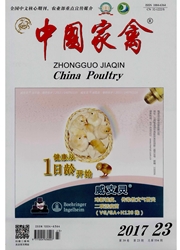

 中文摘要:
中文摘要:
[Objective] This paper aimed to study the effects of different facilities on laying performance,egg quality and air quality for commercial layers under free range system.[Method] The single factorial arrangement was used in the trial.2 800 commercial Beijing You Chicken (BYC) at 23 weeks of age were chosen and randomly divided into four groups,three replicates each group,and 210 birds each replicate.The layers lived in loose housing condition with deep litter inside.Group 1 was the control,equipped with standard laying boxes,and flat-type perches;group 2 was equipped with common laying boxes,and flat-type perches;group 3 was equipped with common laying boxes,and erect-type perches,and group 4 was equipped with standard laying boxes,and erect-type perches.The laying performance,laying position and egg quality of birds during 24 to 32 weeks of age were recorded and measured,and average NH3,CO2 concentration of each group at 32 weeks of age were measured and detected.[Result] The results showed that laying performance of commercial BYC under loose housing condition were significantly different during 24-32 weeks of age.The laying rate of the control group equipped with flat-type perches and standard laying boxes (33.25%) was significantly higher than in group equipped with flat-type perches and common laying boxes (21.83%) (P<0.05),and other two groups (26.04% and 27.48%) (P<0.05).The ratio of floor eggs was significantly lower in groups with standard laying boxes than in the groups with common laying boxes (P<0.05),and the laying proportion in the first floor of layer boxes were much higher than those in the second floor (P<0.05).There were no significant differences on egg quality among the groups (P>0.05).Average NH3,CO2 concentration of group 3 and 4 at 32 weeks of age were both significantly higher than of group 1 and 2 (P<0.05).[Conclusion] All of the above indicated that the utilization of facilities could improve layer’s laying rate,especially with flat-type perches and standard laying boxes,and the indoor
 英文摘要:
英文摘要:
[ Objective] This paper aimed to study the effects of different facilities on laying performance, egg quality and air quality for commercial layers under free range system. [Metbod] The single factorial arrangement was used in the tdal. 2 800 commercial Beijing You Chicken (BYC) at 23 weeks of age were chosen and randomly divided into four groups, three replicates each group, and 210 birds each replicate. The layers lived in loose housing condition with deep litter inside. Group 1 was the control, equipped with standard laying boxes, and flat-type perches; group 2 was e- quipped with common laying boxes, and flat-type perches; group 3 was equipped with common laying boxes, and erect-type perches, and group 4 was equipped with standard laying boxes, and erect-type perches. The laying performance, laying position and egg quality of birds during 24 to 32 weeks of age were recorded and measured, and average NH3, CO~ concentration of each group at 32 weeks of age were measured and detected. [Result] The results showed that laying performance of commercial BYC under loose housing condition were significantly different during 24 -32 weeks of age. The laying rate of the control group equipped with flat-type porches and standard laying boxes (33.25%) was significantly higher than in group equipped with flat-type perches and common laying boxes (21.83%) (P〈0.05), and other two groups (26.04% and 27.48%) (P 〈0.05). The ratio of floor eggs was significantly lower in groups with standard laying boxes than in the groups with common laying boxes (P 〈0. 05), and the laying proportion in the first floor of layer boxes were much higher than those in the second floor ( P 〈 0.05). There were no significant differences on egg quality among the groups (P〉0.05). Average NH3, CO2 concentration of group 3 and 4 at 82 weeks of age were both signifi- cantly higher than of group 1 and 2 (P 〈0.05). [ Conclusion] All of the above indicated that the utilization of facilities could improve lay
 同期刊论文项目
同期刊论文项目
 同项目期刊论文
同项目期刊论文
 期刊信息
期刊信息
